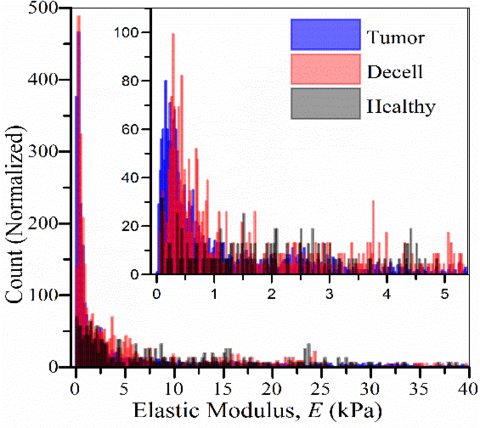Atomic Force Microscopy Methods for Soft Materials
Summary
We are working to develop methods and refine experimental techniques to quantify the mechanical properties of soft and biological materials utilizing atomic force microscopy (AFM). Materials of interest include organic thin films, hydrogel materials, biological tissues, and trace evidence materials such as human hair and fingerprints.
Description

The modulus was shown to vary from 0.11 kPa (at 10 wt%) to 22.2 kPa (at 20 wt%) with pore sizes on the order of 1 nm at large indentation loads (500 nN); viscoelastic time constants were unimodal at 0.20 s while poroelastic time constants showed a broad distribution and evidence of constricted, non-equilibrium flow at low indentation loads and high weight fractions. Early studies focused on the interfacial mechanical properties (e.g., adhesion, friction, elastic modulus) of n-alkylsilane monolayers (SAMs) on silicon with applications in controlling the stiction phenomenon for microfabricated devices, the results of which showed that adhesion and friction are strongly dependent on the chain length and packing density of the SAM molecules1. Friction force microscopy was also used to determine the properties of native versus fibronectin functionalized collagen fibers to better understand how properties of the extracellular matrix (ECM) control cell proliferation and differentiation2. More recent studies utilized colloidal probe indentation to extract time-dependent poroviscoelastic properties of poly(ethylene) glycol (PEG) based hydrogel networks3. Spectroscopic force-relaxation experiments were conducted on PEG-hydrogels of varying weight fraction and modeled to extract transient time constants and elastic moduli. The modulus was shown to vary from 0.11 kPa (at 10 wt%) to 22.2 kPa (at 20 wt%) with pore sizes on the order of 1 nm at large indentation loads (500 nN); viscoelastic time constants were unimodal at 0.20 s while poroelastic time constants showed a broad distribution and evidence of constricted, non-equilibrium flow at low indentation loads and high weight fractions.
Lastly, force spectroscopy experiments were conducted on transgenic breast cancer tumors and decellularized ECM tissue from mouse models to determine the role of substrate stiffness on chemotherapeutic response4. AFM measurements demonstrate that freshly isolated breast tumors are compliant, characterized by a primary stiffness regime between 0.1 to 5 kPa, while ECM tissue without influence from embedded cells exhibited a trimodal rigidity distribution with a narrow maxima at 0.52 kPa (image above). Polyacrylamide gels were prepared to mimic the native ECM tissue and used to test chemotherapeutic response relative to commonly used rigid control substrates. It was found that drug response was profoundly altered by the mechanical feedback cells received from the culture substratum. These findings present an opportunity to improve drug discovery efforts by integrating mechanical rigidity as an adjustable parameter in screening campaigns.
Future work is expected to continue our focus on hydrogel networks for tissue engineering and biomedical applications, as well begin exploration of AFM applicability in the trace evidence field of forensics. Preliminary AFM work related to forensics applications include the differentiation of human hair as a function of treatment, age, and environmental factors5.
Related Publications
S.H. Medina, B.G. Bush, et al., “Identification of a mechanogenetic link between substrate stiffness and chemotherapeutic response in breast cancer.” Biomaterials, Vol. 202, pp. 1-11 (2019)
A. Gayle, B.G. Bush, et al., “Investigating Atomic Force Microscopy for Forensic Evidence Analysis of Hair from Individuals.” Sigma Xi SURF Colloquium award for Best Speaker, Summer 2017
B.G. Bush, J.M. Shapiro, et al., “Mechanical measurements of heterogeneity and length scale effect in PEG-based hydrogels.” Soft Matter, Vol. 11, pp. 7191-7200 (2015)
B. G. Bush, F.W. Delrio, et al., “Interfacial Mechanical Properties of n-Alkylsilane Monolayers on Silicon Substrates.” J. MEMS, Vol. 22, No. 1, pp. 34-43 (2013)
K.-H. Chung, A. Chen, et al., “Frictional properties of native and functionalized type I collagen thin films.” Applied Physics Letters, Vol. 103, pp. 143703 (2013)
Contacts
-
(301) 975-5409

